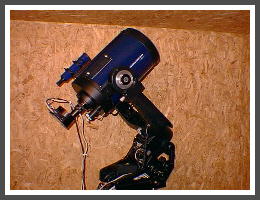Balancing the telescope is essential for the drives to perform correctly while calibrating and guiding. If the telescope is out of balance especially in declination, the gears in the dec drive will have more force on one side than the other. For instance, when the dec knob is released and the telescope, camera, and accessories cause it to point straight up, the dec motor has to exert more torque to move it back to the horizontal position. Hardly any torque is required to move the scope to the vertical position. This will seriously hamper the calibration and the guiding of the camera/telescope. Add counterweights to achieve balance in the declination of the oject to be imaged.
A dew shield also helps counter-balance the telescope eliminating the need for weights.
After balancing the equipment, set the dec backlash parameter in the LX200. Insert an illuminated reticle and focus in on a star. Put the star in the crosshair/bullseye and put the slew speed on 'guide', then press the 'N" or "S" and see how many seconds it takes for the star to start moving. Count the number of seconds it took and multiply it by 15. Example: it took 3 seconds for the star to move then enter 45 (3x15) in the 'Backlash' parameters. This is covered in the manual but is very important!
After balancing and setting the backlash the next step is to focus the ST7.
Back to main menu.

